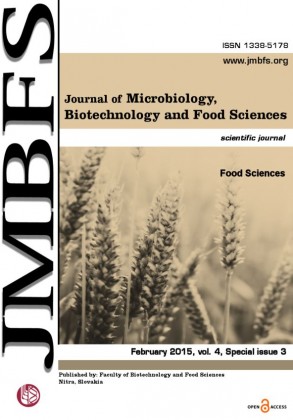CHANGES IN AMARANTH POLYPHENOL CONTENT DURING THE DIFFERENT VEGETATION PHASES
DOI:
https://doi.org/10.15414/jmbfs.2015.4.special3.177-180Keywords:
Amaranth, polyphenolics, anatomical parts, growth phaseAbstract
Total content of polyphenols was investigated in different anatomical parts of amaranth during different growth periods. Five amaranth cultivars were included in the experiment (Amaranthus hypochondriacus L.: cultivars Annapurna and Koniz, Amaranthus caudatus L.: cultivar Oscar Blanco, Amaranthus cruentus L.: cultivars Golden Giant and Rawa). Analysis were done in 4 growth phases: phase I. – intensive stem growth, phase II. – formation of the flowers and pollination, phase III. – milky ripeness, phase IV. – full ripeness. Based on the determined total polyphenol content in amaranth it is possible to create this anatomical part order: leaves > flowers > seeds > stems. No statistically significant differences were confirmed between phases I., III. and IV. On the other hand the total polyphenol content in amaranth determined in growth phase II. was significantly different in comparison to other growth phases. Statistically significant differences in polyphenolic content were confirmed between all investigated anatomical parts of amaranth.Downloads
Download data is not yet available.
Downloads
Published
2015-02-02
How to Cite
Vollmannová, A., Margitanová, E., Bystrická, J., Bojňanská, T., Urminská, D., ÄŒiÄová, I., & Benková, M. (2015). CHANGES IN AMARANTH POLYPHENOL CONTENT DURING THE DIFFERENT VEGETATION PHASES. Journal of Microbiology, Biotechnology and Food Sciences, 4(special issue 3 (Food Sciences), 177–180. https://doi.org/10.15414/jmbfs.2015.4.special3.177-180
Issue
Section
Food Sciences
License
Copyright (c) 2015 Alena Vollmannová, Eva Margitanová, Judita Bystrická, Tatiana Bojňanská, Dana Urminská, Iveta ÄŒiÄová, Michaela Benková

This work is licensed under a Creative Commons Attribution 4.0 International License.
All papers published in the Journal of Microbiology, Biotechnology and Food Sciences are published under a CC-BY licence (CC-BY 4.0). Published materials can be shared (copy and redistribute the material in any medium or format) and adapted (remix, transform, and build upon the material for any purpose, even commercially) with specifying the author(s).





